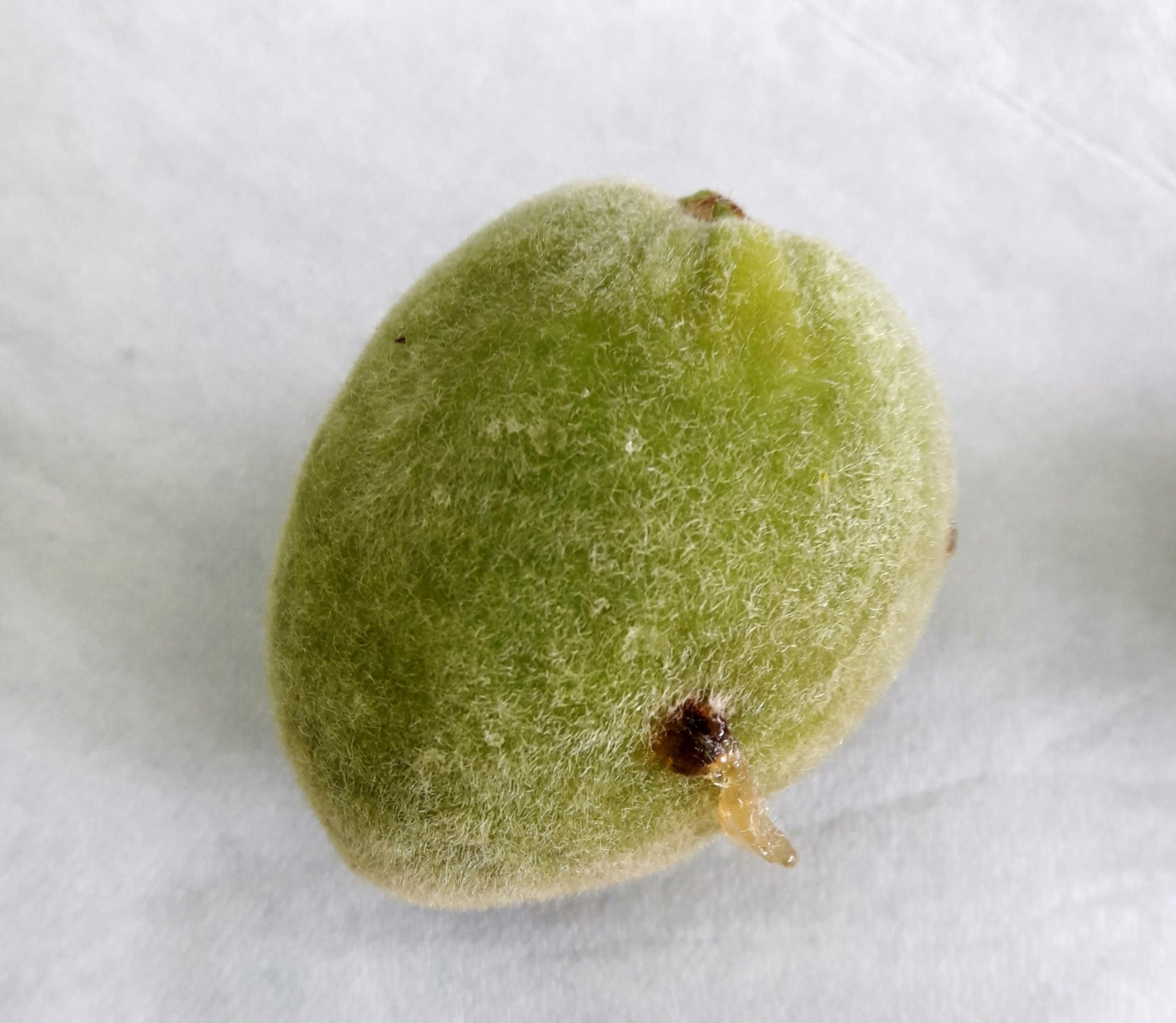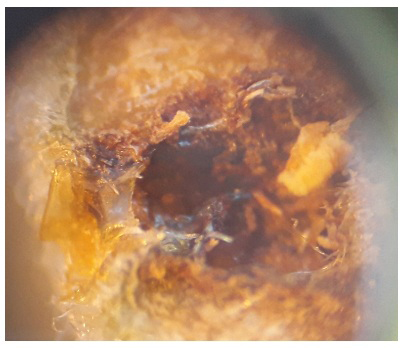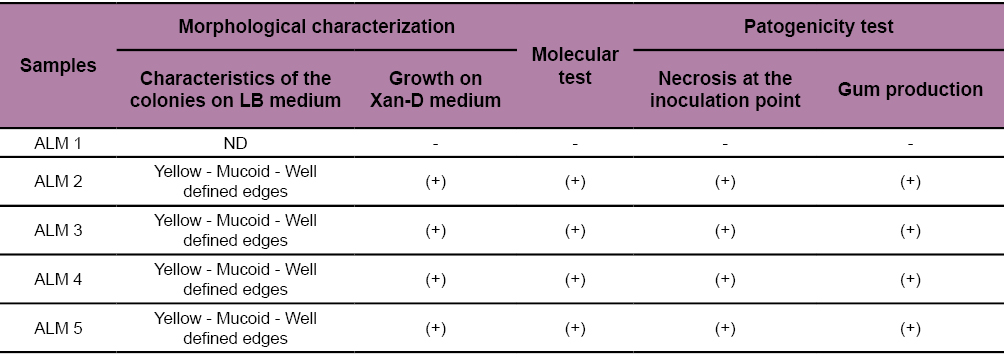INTRODUCTION
Bacterial Spot of Almond is a pathology caused by Xanthomonas arboricola pv. pruni. This disease occurs on leaves, branches and fruits of almost all Prunus species. On almond trees, it can be observed on leaves and buds, but the most evident symptoms are observed on fruits (Adaskaveg et al., 2015). Regarding symptoms on immature fruits, lesions begin in the shell as small watery brown spots that slowly increase in diameter (2 to 4 mm, generally smaller than 5 mm). These lesions produce a light to dark amber gummy substance, whose color is important because it helps to distinguish bacterial spot from other types of damage (Adaskaveg et al., 2015).
Bacterial Spot caused by Xanthomonas arboricola pv. pruni was described for the first time in the United States on Japanese plum (Smith, 1903) and, lately, it is being reported in almost every continent where stone fruits are grown (EPPO, 2006). It has been determined on almond trees in Japan (Ishiyama, 1923), Sicily (Italy) (Ciccarone, 1959), New Zealand (Young, 1977), Spain (Palacio-Bielsa et al., 2010), Australia and California (United States) (Adaskaveg et al., 2015). Previous studies indicate that this pathogen led to reduction in the quality and marketability of fruit, reduction in orchard productivity and increases in production costs, resulting in significant economic losses (Lamichhane, 2014).
The leading almond producer in the world is the United States, followed by Spain. Also, Australia emerges as a strong growing producer. In Argentina, in recent years, the sector has been recovered and modern plantations with late bloom varieties were incorporated (Iannamico, 2015). Currently, there are about 4,200 cultivated hectares, mainly distributed in the provinces of Mendoza, San Juan, La Rioja, Salta, Río Negro and Neuquén. In Río Negro (Northern Patagonia), growing areas are mainly located in the High Valley productive region, while smaller orchards are located in the Lower Valley and Middle Valley productive regions (Iannamico, 2015). Although the almond trees integrate a group of fruit trees that are not traditionally grown in Northern Patagonia, it has enormous potential due to its agronomic behavior and its good profitability and growth possibilities (Iannamico, 2015).
During October 2017 in cultivars of Luis Beltrán, a productive region of the Middle Valley of Río Negro, young almond fruits with external lesions were observed. Symptoms consisted of small watery circular lesions, from which an amber gummy substance emerged (fig. 1). The objective of this work was to determine the etiology of this pathology, considering that the symptoms were coincident with those previously described for diseases caused by Xanthomonas arboricola pv. pruni and the fact that Xanthomonas arboricola pv. juglandis had previously been reported in the region as a causal agent of Walnut Blight and Brown Apical Necrosis (Temperini et al., 2017).
MATERIALS AND METHODS
A total of 5 symptomatic immature almond fruits were chosen for analysis. The fruits were washed with tap water, superficially disinfected by soaking them in a solution of 1% Sodium Hypochlorite (NaClO) for 3 minutes, and rinsed twice with sterile distilled water. Then, they were placed individually in closed plastic jars, containing a piece of sterilized cotton soaked in water to create a wet chamber to allow microbial development. They were incubated at 27 °C for 14 days. After the incubation period, internal pieces of injured tissue were aseptically removed and placed in Eppendorf tubes containing sterile physiological solution. After homogenization, 0.1 ml of the suspension was inoculated in Petri dishes containing Luria Bertani (LB) medium. They were incubated at 27 °C for 4 days. Colonies that showed morphological characteristics equal or similar to those described for the genus Xanthomonas on LB medium were cultured on a differential medium for this genus, Xan-D (Yung-Ann et al., 2009). They were incubated at 27 °C for 7 days. The colonies that were positive on the Xan-D medium were confirmed by molecular techniques.
DNA extractions were performed using the “DNeasy blood and tissue mini kit” with a pre-treatment protocol for gram-negative bacteria as for the manufacturer’s instructions (Qiagen, Intl.). The extracted genomic DNA was quantified with a fluorimeter Qubit 2.0 (Life Technologies, Intl.). PCR amplifications were performed using Xanthomonas species-specific primers XarbQF (GCGAGATCAATGCGACCTCGTC) and XarbQR (GGTGACCACATCGAACCGCGCA) for qumA gene, a quinate dehydrogenase (Pothier et al., 2011), according to Temperini et al. (2017). After molecular identification, Xanthomonas isolates were stored at -80 °C in broth Yeast Extract Peptone Dextrose.
Pathogenicity tests were conducted on 8 healthy immature almonds fruits, 40 days after the setting, and the results were verified according to Koch’s postulates. The disinfected fruits were injured at a depth of 0.1 mm in the equatorial area with a sterile needle and inoculated in the same way with bacterial culture grown for 4 days in Nutrient Agar. The fruits were placed individually in closed plastic jars in a humid chamber, as previously described, and incubated at 25 °C for 15 days. Controls were inoculated with sterile distilled water. After the incubation period, the injuries produced were evaluated and the production of gum was observed under a stereoscopic microscope (40X).
RESULTS AND DISCUSSION
The presence of Xanthomonas arboricola was determined in 4 of the 5 affected fruits under study. Regarding pathogenicity tests, all the fruits inoculated showed the characteristic symptomatology, necrosis and gum production (fig. 2). The pathogenicity was demonstrated according to Koch’s postulates. These results are summarized in table 1. As a result, we can confirm Xanthomonas arboricola pv. pruni as the causal agent of Bacterial Spot with gum production in almond fruits of the Middle Valley of Río Negro. This is the first report of the disease in Argentina.
Among the pathogens that attack Prunus species, Xanthomonas arboricola has become very important in recent decades. Outbreaks caused by this bacterium have increased in recent years, and the speed at which they occur suggests the possibility of future epidemics, which has made it a worldwide concern (Lamichhane, 2014). In the region, Xanthomonas arboricola was previously reported in walnut trees and is the causal agent of bacteriosis and Brown Apical Necrosis. These pathologies are responsible for significant losses in the production sector, and are very severe in seasons of predisposing climatic conditions (Temperini et al., 2017).
This report alerts to the presence of the pathogen in the Northern Patagonia and the need to address preventive measures to avoid the emergence and spread of the disease.
















